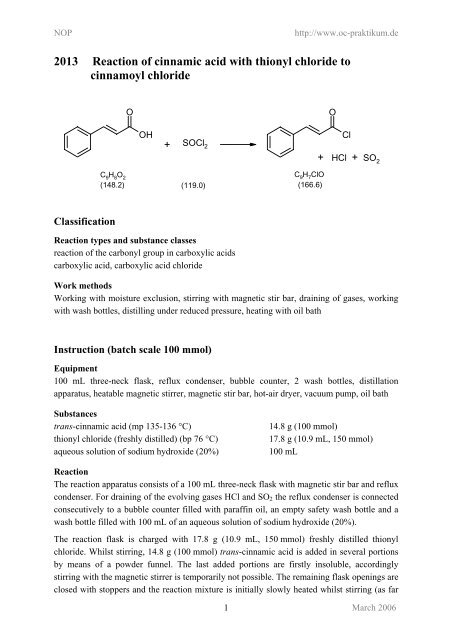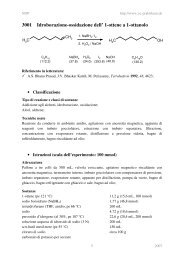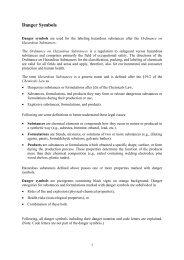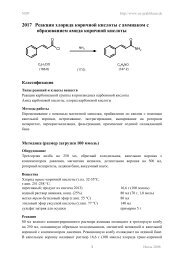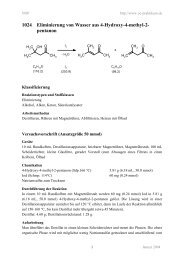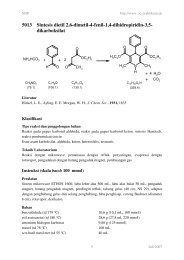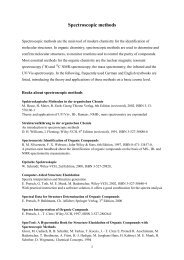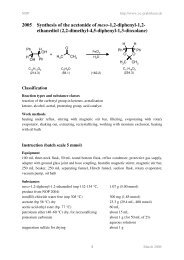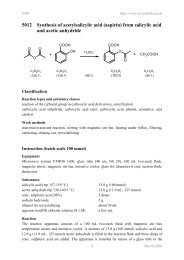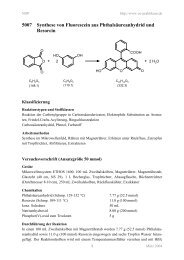2013 Reaction of cinnamic acid with thionyl chloride to ... - kriemhild
2013 Reaction of cinnamic acid with thionyl chloride to ... - kriemhild
2013 Reaction of cinnamic acid with thionyl chloride to ... - kriemhild
You also want an ePaper? Increase the reach of your titles
YUMPU automatically turns print PDFs into web optimized ePapers that Google loves.
NOP http://www.oc-praktikum.de<br />
<strong>2013</strong> <strong>Reaction</strong> <strong>of</strong> <strong>cinnamic</strong> <strong>acid</strong> <strong>with</strong> <strong>thionyl</strong> <strong>chloride</strong> <strong>to</strong><br />
cinnamoyl <strong>chloride</strong><br />
Classification<br />
O O<br />
OH<br />
+ SOCl 2<br />
C 9 H 8 O 2<br />
(148.2) (119.0)<br />
<strong>Reaction</strong> types and substance classes<br />
reaction <strong>of</strong> the carbonyl group in carboxylic <strong>acid</strong>s<br />
carboxylic <strong>acid</strong>, carboxylic <strong>acid</strong> <strong>chloride</strong><br />
1<br />
C 9 H 7 ClO<br />
(166.6)<br />
Cl<br />
+ HCl + SO 2<br />
Work methods<br />
Working <strong>with</strong> moisture exclusion, stirring <strong>with</strong> magnetic stir bar, draining <strong>of</strong> gases, working<br />
<strong>with</strong> wash bottles, distilling under reduced pressure, heating <strong>with</strong> oil bath<br />
Instruction (batch scale 100 mmol)<br />
Equipment<br />
100 mL three-neck flask, reflux condenser, bubble counter, 2 wash bottles, distillation<br />
apparatus, heatable magnetic stirrer, magnetic stir bar, hot-air dryer, vacuum pump, oil bath<br />
Substances<br />
trans-<strong>cinnamic</strong> <strong>acid</strong> (mp 135-136 °C) 14.8 g (100 mmol)<br />
<strong>thionyl</strong> <strong>chloride</strong> (freshly distilled) (bp 76 °C) 17.8 g (10.9 mL, 150 mmol)<br />
aqueous solution <strong>of</strong> sodium hydroxide (20%) 100 mL<br />
<strong>Reaction</strong><br />
The reaction apparatus consists <strong>of</strong> a 100 mL three-neck flask <strong>with</strong> magnetic stir bar and reflux<br />
condenser. For draining <strong>of</strong> the evolving gases HCl and SO2 the reflux condenser is connected<br />
consecutively <strong>to</strong> a bubble counter filled <strong>with</strong> paraffin oil, an empty safety wash bottle and a<br />
wash bottle filled <strong>with</strong> 100 mL <strong>of</strong> an aqueous solution <strong>of</strong> sodium hydroxide (20%).<br />
The reaction flask is charged <strong>with</strong> 17.8 g (10.9 mL, 150 mmol) freshly distilled <strong>thionyl</strong><br />
<strong>chloride</strong>. Whilst stirring, 14.8 g (100 mmol) trans-<strong>cinnamic</strong> <strong>acid</strong> is added in several portions<br />
by means <strong>of</strong> a powder funnel. The last added portions are firstly insoluble, accordingly<br />
stirring <strong>with</strong> the magnetic stirrer is temporarily not possible. The remaining flask openings are<br />
closed <strong>with</strong> s<strong>to</strong>ppers and the reaction mixture is initially slowly heated whilst stirring (as far<br />
March 2006
NOP http://www.oc-praktikum.de<br />
as possible) in an oil bath (strong formation <strong>of</strong> gas!) up <strong>to</strong> 50 °C bath temperature, afterwards<br />
stirring is continued for 2 additional hours at 80 °C bath temperature.<br />
Work up<br />
After the cooling down <strong>of</strong> the reaction mixture, the reflux condenser is replaced by a<br />
distillation bridge and the excess <strong>of</strong> <strong>thionyl</strong><strong>chloride</strong> is removed by distillation under reduced<br />
pressure (about 20 hPa). A trap between apparatus and vacuum pump, which is cooled <strong>with</strong><br />
liquid nitrogen is used <strong>to</strong> condensate the <strong>thionyl</strong> <strong>chloride</strong>. A yellowish solid remains as<br />
residue.<br />
Crude yield: 13.5 g (81.0 mmol, 81%); mp 30-33 °C<br />
The crude <strong>acid</strong> <strong>chloride</strong> is for most uses pure enough, so that one can do <strong>with</strong>out distillation.<br />
For further purification a fractional distillation at 1 hPa is required. A trap between apparatus<br />
and vacuum pump, which is cooled <strong>with</strong> liquid nitrogen serves <strong>to</strong> condensate the last amounts<br />
<strong>of</strong> <strong>thionyl</strong> <strong>chloride</strong>. To avoid a crystallization <strong>of</strong> the product in the condenser <strong>of</strong> the<br />
distillation bridge, it is only air-cooled and, if necessary, the condenser is briefly heated <strong>with</strong> a<br />
hot-air dryer. The product is a colourless, strong refractive liquid, which crystallizes whilst<br />
cooling as a colourless solid product.<br />
Yield: 12.2 g (73.2 mmol, 73%); bp 75-80 °C (0.1 hPa), mp 30-33 °C<br />
Distillation residue: about 1 g <strong>of</strong> a brown solid<br />
Comments<br />
In experiment Number 2017 this product is used as educt.<br />
One should calculate the volume <strong>of</strong> the NaOH-solution in the wash bottle so that the building<br />
gases HCl and SO2 are completely absorbed.<br />
Waste management<br />
Waste disposal<br />
Waste Disposal<br />
excess <strong>of</strong> <strong>thionyl</strong> <strong>chloride</strong> dissolve in diluted aqueous NaOH-solution, then:<br />
aqueous waste, alkaline<br />
solution from the wash bottle aqueous waste, alkaline<br />
distillation residue dissolve in a small amount <strong>of</strong> ace<strong>to</strong>ne, then:<br />
organic solvents, containing halogen<br />
Time<br />
Without distillation about 4 hours, distillation 1 hour<br />
Break<br />
Before distillation <strong>of</strong> the <strong>thionyl</strong> <strong>chloride</strong><br />
Degree <strong>of</strong> difficulty<br />
Medium<br />
2<br />
March 2006
NOP http://www.oc-praktikum.de<br />
Instruction (batch scale 10 mmol)<br />
Equipment<br />
50 mL two-neck flask, reflux condenser, bubble counter, 2 wash bottles, distillation<br />
apparatus, heatable magnetic stirrer, magnetic stir bar, hot-air dryer, vacuum pump, oil bath<br />
Substances<br />
trans-<strong>cinnamic</strong> <strong>acid</strong> (mp 135-136 °C) 1.48 g (10.0 mmol)<br />
<strong>thionyl</strong> <strong>chloride</strong> (freshly distilled) bp 76 °C) 1.8 g (1.1 mL, 15 mmol)<br />
aqueous solution <strong>of</strong> sodium hydroxide (20%) 20 mL<br />
<strong>Reaction</strong><br />
The reaction apparatus consists <strong>of</strong> a 50 mL two-neck flask <strong>with</strong> magnetic stir bar and reflux<br />
condenser. For draining the evolving gases HCl und SO2, the reflux condenser is connected<br />
consecutively <strong>to</strong> a bubble counter filled <strong>with</strong> paraffin oil, an empty safety wash bottle and a<br />
wash bottle filled <strong>with</strong> 20 mL <strong>of</strong> an aqueous solution <strong>of</strong> sodium hydroxide (20%).<br />
The reaction flask is charged <strong>with</strong> 1.8 g (1.1 mL, 15 mmol) freshly distilled <strong>thionyl</strong> <strong>chloride</strong>.<br />
Whilst stirring 1.48 g (10.0 mmol) trans-<strong>cinnamic</strong> <strong>acid</strong> are added by means <strong>of</strong> a powder<br />
funnel in several portions. The remainig flask openings are closed <strong>with</strong> s<strong>to</strong>ppers and the<br />
reaction mixture is initially slowly heated in an oil bath (strong formation <strong>of</strong> gas!) up <strong>to</strong> 50 °C<br />
bath temperature, afterwards stirring is continued for two additional hours at 80 °C bath<br />
temperature.<br />
Work up<br />
After cooling down <strong>of</strong> the reaction mixture the reflux condenser is replaced by a distillation<br />
bridge and the excess <strong>of</strong> <strong>thionyl</strong> <strong>chloride</strong> is removed by distillation under reduced pressure<br />
(about 20 hPa). A trap between apparatus and vacuum pump, which is cooled <strong>with</strong> liquid<br />
nitrogen is used <strong>to</strong> condensate the <strong>thionyl</strong> <strong>chloride</strong>. A yellowish solid remains as residue.<br />
Crude yield 1.40 g (8.40 mmol, 84%); mp 30-33 °C<br />
The crude <strong>acid</strong> <strong>chloride</strong> is pure enough for most uses, so that one can do <strong>with</strong>out distillation.<br />
According <strong>to</strong> the used apparatus the distillation at the small batch scale is loss making.<br />
If a further purification <strong>of</strong> the crude product is required, it is distilled at 1 hPa.. A trap<br />
between apparatus and vacuum pump, which is cooled <strong>with</strong> liquid nitrogen, serves <strong>to</strong><br />
condensate the last amounts <strong>of</strong> <strong>thionyl</strong> <strong>chloride</strong>. To avoid a crystallization <strong>of</strong> the product in<br />
the condenser <strong>of</strong> the distillation bridge, it is only air-cooled and, if necessary, the condenser is<br />
briefly heated <strong>with</strong> a hot-air dryer. The product is a colourless, strong refractive liquid, which<br />
crystallizes whilst cooling as a colourless solid.<br />
Yield: 950 mg (5.70 mmol, 57%); Sdp 75-80 °C (0.1 hPa), mp 30-33 °C<br />
Distillation residue: small amount <strong>of</strong> a brown solid<br />
Comments<br />
In experiment Number 2017 this product is used as educt.<br />
3<br />
March 2006
NOP http://www.oc-praktikum.de<br />
One should calculate the volume <strong>of</strong> the NaOH-solution in the wash bottle so that the building<br />
gases HCl and SO2 are completely absorbed.<br />
Waste management<br />
Waste disposal<br />
Waste Disposal<br />
excess <strong>of</strong> <strong>thionyl</strong> <strong>chloride</strong> dissolve in diluted aqueous NaOH-solution, then:<br />
aqueous waste, alkaline<br />
solution from wash bottle aqueous waste, alkaline<br />
distillation residue dillute in a small amount <strong>of</strong> ace<strong>to</strong>ne, then:<br />
organic solvents, containing halogen<br />
Time<br />
Without distillation about 3.5 hours, distillation 30 minutes<br />
Break<br />
Before distillation <strong>of</strong> the <strong>thionyl</strong> <strong>chloride</strong><br />
Degree <strong>of</strong> difficulty<br />
Medium<br />
Analytics<br />
<strong>Reaction</strong> control<br />
The end <strong>of</strong> gas formation is a rough indica<strong>to</strong>r for the end <strong>of</strong> reaction.<br />
4<br />
March 2006
NOP http://www.oc-praktikum.de<br />
1 H NMR spectrum <strong>of</strong> the pure product (250 MHz, CDCl3)<br />
12<br />
11<br />
10<br />
9<br />
8<br />
7<br />
(ppm)<br />
8.0<br />
6<br />
5<br />
δ (ppm) Multiplicity Connection constant (Hz) Number <strong>of</strong> H Assignment<br />
6.64 D JAB = 15.5 1 HA<br />
7.39 – 7.61 M 5 CH arene<br />
7.85 D JAB = 15.5 1 HB<br />
The 1 H NMR-Spectrum <strong>of</strong> the undistilled <strong>acid</strong> <strong>chloride</strong> is identical <strong>with</strong> that <strong>of</strong> the pure product.<br />
13 C NMR spectrum <strong>of</strong> the pure product (250 MHz, CDCl3)<br />
180<br />
160<br />
140<br />
(ppm)<br />
δ (ppm) Assignment<br />
122.38 – CH = CH – COCl<br />
129.13 CH aromatic<br />
129.28 CH aromatic<br />
132.07 CH aromatic<br />
133.06 Cquart aromatic<br />
150.75 – CH = CH – COCl<br />
166.16 – COCl<br />
76.5-77.5 solvent<br />
120<br />
100<br />
80<br />
7.5<br />
4<br />
5<br />
60<br />
(ppm)<br />
3<br />
7.0<br />
40<br />
2<br />
1<br />
20<br />
6.5<br />
0<br />
0<br />
H<br />
B<br />
H A<br />
O<br />
Cl<br />
March 2006


